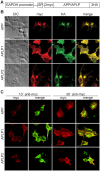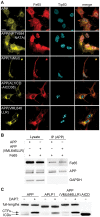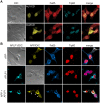Turnover of amyloid precursor protein family members determines their nuclear signaling capability
- PMID: 23874953
- PMCID: PMC3715505
- DOI: 10.1371/journal.pone.0069363
Turnover of amyloid precursor protein family members determines their nuclear signaling capability
Abstract
The amyloid precursor protein (APP) as well as its homologues, APP-like protein 1 and 2 (APLP1 and APLP2), are cleaved by α-, β-, and γ-secretases, resulting in the release of their intracellular domains (ICDs). We have shown that the APP intracellular domain (AICD) is transported to the nucleus by Fe65 where they jointly bind the histone acetyltransferase Tip60 and localize to spherical nuclear complexes (AFT complexes), which are thought to be sites of transcription. We have now analyzed the subcellular localization and turnover of the APP family members. Similarly to AICD, the ICD of APLP2 localizes to spherical nuclear complexes together with Fe65 and Tip60. In contrast, the ICD of APLP1, despite binding to Fe65, does not translocate to the nucleus. In addition, APLP1 predominantly localizes to the plasma membrane, whereas APP and APLP2 are detected in vesicular structures. APLP1 also demonstrates a much slower turnover of the full-length protein compared to APP and APLP2. We further show that the ICDs of all APP family members are degraded by the proteasome and that the N-terminal amino acids of ICDs determine ICD degradation rate. Together, our results suggest that different nuclear signaling capabilities of APP family members are due to different rates of full-length protein processing and ICD proteasomal degradation. Our results provide evidence in support of a common nuclear signaling function for APP and APLP2 that is absent in APLP1, but suggest that APLP1 has a regulatory role in the nuclear translocation of APP family ICDs due to the sequestration of Fe65.
Conflict of interest statement
Figures








Similar articles
-
Visualization and quantification of APP intracellular domain-mediated nuclear signaling by bimolecular fluorescence complementation.PLoS One. 2013 Sep 25;8(9):e76094. doi: 10.1371/journal.pone.0076094. eCollection 2013. PLoS One. 2013. PMID: 24086696 Free PMC article.
-
The APP intracellular domain forms nuclear multiprotein complexes and regulates the transcription of its own precursor.J Cell Sci. 2004 Sep 1;117(Pt 19):4435-48. doi: 10.1242/jcs.01323. J Cell Sci. 2004. PMID: 15331662
-
Co-localization of the amyloid precursor protein and Notch intracellular domains in nuclear transcription factories.Neurobiol Aging. 2010 Jan;31(1):58-73. doi: 10.1016/j.neurobiolaging.2008.03.001. Epub 2008 Apr 10. Neurobiol Aging. 2010. PMID: 18403052 Free PMC article.
-
The FE65 proteins and Alzheimer's disease.J Neurosci Res. 2008 Mar;86(4):744-54. doi: 10.1002/jnr.21532. J Neurosci Res. 2008. PMID: 17828772 Review.
-
A putative role of the Amyloid Precursor Protein Intracellular Domain (AICD) in transcription.Acta Neurobiol Exp (Wars). 2008;68(2):219-28. doi: 10.55782/ane-2008-1691. Acta Neurobiol Exp (Wars). 2008. PMID: 18511958 Review.
Cited by
-
Click Chemistry-mediated Biotinylation Reveals a Function for the Protease BACE1 in Modulating the Neuronal Surface Glycoproteome.Mol Cell Proteomics. 2018 Aug;17(8):1487-1501. doi: 10.1074/mcp.RA118.000608. Epub 2018 May 1. Mol Cell Proteomics. 2018. PMID: 29716987 Free PMC article.
-
APLP1 Is a Synaptic Cell Adhesion Molecule, Supporting Maintenance of Dendritic Spines and Basal Synaptic Transmission.J Neurosci. 2017 May 24;37(21):5345-5365. doi: 10.1523/JNEUROSCI.1875-16.2017. Epub 2017 Apr 27. J Neurosci. 2017. PMID: 28450540 Free PMC article.
-
The C99 domain of the amyloid precursor protein resides in the disordered membrane phase.J Biol Chem. 2021 Jan-Jun;296:100652. doi: 10.1016/j.jbc.2021.100652. Epub 2021 Apr 9. J Biol Chem. 2021. PMID: 33839158 Free PMC article.
-
A synthetic antibody fragment targeting nicastrin affects assembly and trafficking of γ-secretase.J Biol Chem. 2014 Dec 12;289(50):34851-61. doi: 10.1074/jbc.M114.609636. Epub 2014 Oct 28. J Biol Chem. 2014. PMID: 25352592 Free PMC article.
-
The cellular expression and proteolytic processing of the amyloid precursor protein is independent of TDP-43.Biosci Rep. 2020 Apr 30;40(4):BSR20200435. doi: 10.1042/BSR20200435. Biosci Rep. 2020. PMID: 32301481 Free PMC article.
References
-
- Kang J, Lemaire HG, Unterbeck A, Salbaum JM, Masters CL, et al. (1987) The precursor of Alzheimer’s disease amyloid A4 protein resembles a cell-surface receptor. Nature 325: 733–736. - PubMed
-
- De Strooper B, Annaert W (2000) Proteolytic processing and cell biological functions of the amyloid precursor protein. J Cell Sci 113 (Pt 11): 1857–1870. - PubMed
-
- Hardy J, Selkoe DJ (2002) The amyloid hypothesis of Alzheimer’s disease: progress and problems on the road to therapeutics. Science 297: 353–356. - PubMed
-
- von Rotz RC, Kohli BM, Bosset J, Meier M, Suzuki T, et al. (2004) The APP intracellular domain forms nuclear multiprotein complexes and regulates the transcription of its own precursor. J Cell Sci 117: 4435–4448. - PubMed
-
- Weidemann A, Eggert S, Reinhard FB, Vogel M, Paliga K, et al. (2002) A novel epsilon-cleavage within the transmembrane domain of the Alzheimer amyloid precursor protein demonstrates homology with Notch processing. Biochemistry 41: 2825–2835. - PubMed
Publication types
MeSH terms
Substances
LinkOut - more resources
Full Text Sources
Other Literature Sources
Research Materials
Miscellaneous

